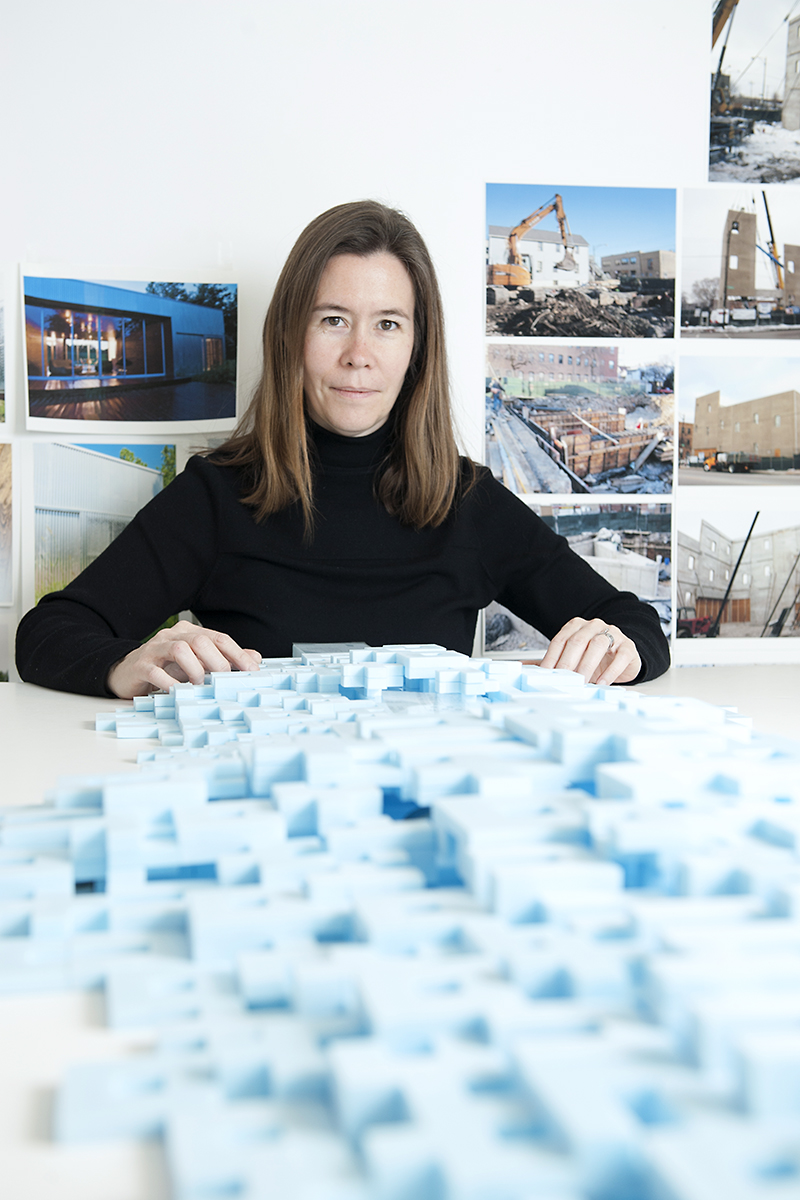Architectural designer’s ideas flow for water projects

Architectural designer Sarah Dunn is working on projects related to water, even bringing water to Death Valley. “What if all of a sudden you had an abundance of water there?” she asks. Photo: Roberta Dupuis-Devlin/UIC Photo Services
As an architectural designer, Sarah Dunn often finds herself thinking about water — bringing it to Death Valley, building “eco-boulevards” to clean and recycle Chicago’s water, and reversing the flow of the Chicago River, to give a few examples.
The associate professor runs the architecture firm UrbanLab with her husband, Martin Felsen.
Most of their work is in the Great Lakes region, but they also have an eye on the American Southwest.
Part of this work engages in what Dunn calls “unsolicited speculation.”
“Nobody asked us to think about the Southwest,” she said.
The region is experiencing rapid growth and related issues like water shortages.
“It has too much of one kind of water and not enough of the other,” Dunn said. “There’s plenty of salt water with rising sea levels, and not enough fresh water.”
One idea is to supply salt water to places that once had water but now are dry, like Death Valley.
“In these super-desert conditions,” she asked, “what if all of a sudden you had an abundance of water there — what could you do?”
Dunn thinks about water crises in the Southwest as “a catalyst for urban invention,” she said.
“A new city-scaled architecture is also infrastructure that transports salt water from the Gulf of Mexico and desalinates it through a series of passive desalination processes.”
Speculative projects like these are aimed at exhibitions, journals and architectural shows known as “biennales.”
“They’re not meant to have clients,” Dunn said. “It’s not like Nevada is saying, ‘Let’s build this aqueduct.’
“It’s theoretical and probably seems a little nuts,” she admitted.
“Our point is you need to think big in order to solve big problems. Can architecture start to think big again?”
Fifty years ago, architects were more involved in planning for cities, she said. “Can we renew that?”
UrbanLab is also at work on “normative” projects for actual clients, Dunn noted, both in the Southwest and locally. Those include a single-family home in Los Angeles, now being completed, and the Upton’s Naturals project in Chicago.
Opened last summer at Grand and Hoyne avenues, the new home of the Upton’s Naturals vegan food manufacturer is 10,000 square feet that includes a seitan production facility, the Upton’s Breakroom café, offices, a yoga studio and an apartment for the owners.
Dunn and Felsen won the History Channel’s national “City of the Future” competition in 2007. Their entry, “Growing Water,” included a proposed reversal of the 1900 reversal of the Chicago River, so the river once again would fill the lake instead of draining it.
But its heart was a plan to clean and recycle the water Chicago draws from Lake Michigan, using a system of canals called “eco-boulevards.”
“On east-west streets, every half-mile or so, it would introduce a new kind of infrastructure, to process stormwater and waste water,” Dunn said. The new park system would be within a quarter-mile of every Chicago resident.
The city’s department of environment, since dissolved, implemented ideas from “Growing Water,” and the department of transportation continues to do so, she said.
Another of her water-related ideas is for “freewater districts” for post-industrial landscapes like the old stockyards.
“A freewater zone would encourage manufacturers heavily dependent on water,” she said. “They could have as much as they want in return for cleaning up the landscape and providing lots of jobs.”
Yet another project involving water, UrbanLab’s design for “Virtual Water” in Queens, N.Y., won a SustainABILITY Leadership award in the 2013 AIA Chicago Design Excellence Awards competition.
Dunn was born in Virginia but left at age 2 and spent about half her childhood in New York City and half in Singapore and Tokyo.
After earning bachelor’s and master’s degrees at Columbia University, she worked for three years in the Office for Metropolitan Architecture, headed by famed architect Rem Koolhaas, in Rotterdam.
Felsen, whom she met at Columbia, began teaching at the Illinois Institute of Technology, and she joined UIC in 2000. They built a home and studio in Bridgeport, where they live with their 6-year-old daughter Aubrey.
“She does not want to be an architect,” her mother said. “She wants to be either an artist or a scientist or a cat-sitter — or maybe all three at the same time.”
Dunn was 5 when she made some remark about a space or building and her mother responded, “Oh, you want to be an architect.”
“I really like designing,” she said. “It doesn’t just solve problems. The best architecture rises above all the constraints and is the sum of more than overcoming the constraints.
“That’s what I’m good at.”
